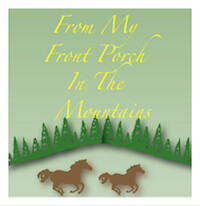Syrup season is now finished for another year but before we part ways with the maples, allow me to share with all of you, how easy and rewarding tapping your own trees can be.
Here are some easy step by step instructions.
Drill a hole in a tree, preferably maple. Did you know you can tap any kind of maple tree, not just a sugar maple? The sugar maple, however, provides the ideal sap.
Gently tap in a spigot with a hammer.
Next, hang your sap bucket on the hook attached to the spigot.
To keep flies, tree debris and 10 year old fingers that could have been anywhere, at any time, out of the bucket, cover with a lid.
The next step is rather important. Please pay close attention.
You must check the bucket for sap, regularly.
This is where you can get into trouble.
The definition of regularly can change on any given day or night. Ideally, warm day time temps and freezing nights keep the sap running quickly but change those up a bit, like mother nature did this year and it's a whole new ball game. Different trees can also produce varying amounts of sap as we discovered. Larger trees can usually accommodate more than one bucket. Until you become familiar with your trees and how much sap they are producing, you should check your buckets at least once day.
Be prepared to have somewhere to store your sap after it has been collected, waiting to be boiled down. Don't wait too long, however; the collected sap shouldn't sit more than a couple of days. There are two tell tale signs to know when you should stop collecting sap and hang up your buckets for another year. The sap will turn cloudy or murky in the bucket. Although it has a yellowish tinge in the photo above, it's still clear. When it's no longer clear, stop. Also, watch or listen to your trees; once they start to bud, it's time to call it quits. It's their way of saying they need nourishment for healthy foliage.
~Boiling down the syrup~
This is where we separate the faint of heart, also commonly referred to as clean freaks, from the professionals. The professionals have a sugar shack. We have a kitchen and unfortunately I can also be a bit of a clean freak, particularly dans la cuisine. Boiling the syrup leaves very sticky splatters that don't come clean with just a damp cloth. Serious scrubbing will be involved at a later date.
The key to boiling the syrup is to get the sap hot enough for the water to evaporate without burning the sap or having your pan boil over. Trust the Artist on this one, you don't want it to boil over. As it boils gently, foam will rise to the top of the pan. It has a bitter taste so simply skim it off with a slotted spoon, as shown above. As the water evaporates, keep adding more sap. This isn't a quick chore, we used a large roasting pan, which we straddled over two burners and it took roughly 7 -8 hours for it to boil down enough to add more sap and continue boiling.
As it boils, the syrup will darken and you can taste it becoming sweeter. With a candy thermometer, keep an eye on the temperature. As the sugar content goes up, the boiling temperature will also rise. The bubbles will also become smaller as it reaches the critical temperature. At this point add a tablespoon of butter or oil to stop it from foaming over. Syrup is ready when it reaches 107C (225F), adjusted for altitude. For us, this was 104C (219F).
Once you've reached the critical temperature, filter using a cheese cloth and then transfer to jars while still hot, before the temperature drops below 180F (82C).
Jars can be stored in the freezer until ready to be used or 90 days in the fridge.We had an extremely quick and warm spring this year, not the most ideal conditions for syrup collecting. Had it stayed cooler a few weeks longer, I expect we would have ended up with twice as much syrup as we did. Yet we still finished with almost 5 litres (1.1 gallons) of syrup. Used wisely, it should last us through the year. The ratio of sap to finished syrup is 40 to 1 but don't despair. When the temperatures are right, the buckets can fill up quickly.
It also makes messy work of the kitchen and takes a lot of time to boil it all down. This was our first effort; we decided to go slow and only hang six buckets. Eventually, as we add more buckets each spring, the Artist plans to make his own outdoor evaporator to keep the mess and steam outside. Hallelujah!
Financially speaking, we found our syrup making venture to be very easy on the pocket book. To purchase the same amount of quality syrup locally, we could easily spend $100. Our incidental costs, outside of the purchase of the buckets and spigots was only an additional $20 on our propane bill.
All things considered, I think we score high marks for fresh, local and economical produce, not to mention reviving a lost skill of country life. Rural Revival at its best.
~Be well friends~
































13 comments:
Yummy goodness! A friend of mine moves an old stove outside to boil her sap every spring. No mess!
This is amazing! I am so incredibly impressed! I just read the whole post out loud to B. I only just discovered real maple syrup and the pancake syrup I was using before is now just considered a tragedy :) Real maple syrup is like gold around here.... man that stuff is expensive.
Thanks for the syrup lesson. You make it look so fun. At least until you have to stir for 7-8 hours.
Thanks for the step-by-step photos...I'll be sure to try this next season! The kids love pancakes...this will be a great adventure!
Home made syrup sounds wonderful. The one thing I regretted when I was in Vermont last year was not buyins some syrup. You made it look pretty easy. I'm definitely goign to have to try that one of these days.
What a process! A few years ago I had a young girl working for me, who was from Ct. She went home for "syrup season", because they literally had thousands of trees for syrup production! When she came back and showd me pics, I was amazed. This was her parents business, and livlihood. They had a huge staff. It always reminded me of the movie "A Walk in the Clouds."
Trade grapes for syrup!
You guys did a fantastic job! But, being a clean freak, myself...I can only imagine the sticky clean-up :(
You really have become a country girl, Andrea!
xo, misha
Hello Andrea...what a wonderful post!! We don't have any maple tree's here on the farm but we did in Wichita..wish we'd tried this then. I was born and mostly raised in Manitoba where there are many maple tree's but we never did this even though we had many maple tree's in my grandparents and great grandparents yards. Such a shame we missed out on this! I bet that syrup tastes WONDERFUL. I agree with Misha...you really are a country girl for sure! Have a wonderful weekend....Maura:)
Oh yum!
Andrea, this was amazing to see! I've always lived in the south and west so this is totally new for me! You're very blessed to have these trees. If I thought planting some here on the mountain would work, I'd do it in a heart beat!
Can I ask what variety of maple tree most people tap? (You can tell I'm a southern belle as I have no clue and this is probably obvious to anyone up north!).
Land sakes alive, you mean I could have been tapping my silver maples all this time? I've always wanted to plant sugar maples, and that was one of my regrets, that I never got around to doing that, and now - well...let's just say I wouldn't be eating any syrup out of a tree I'd plant now..I really want to do this next year with my silver maples and see what come of it. Thanks so much for posting this!
This is so, so cool. If I lived somewhere where maple trees could actually grow I would so try this. I wonder if it might work on a cactus....yea, probably not!
My kids and I enjoyed this info!! What a great post!
-Trish
Post a Comment